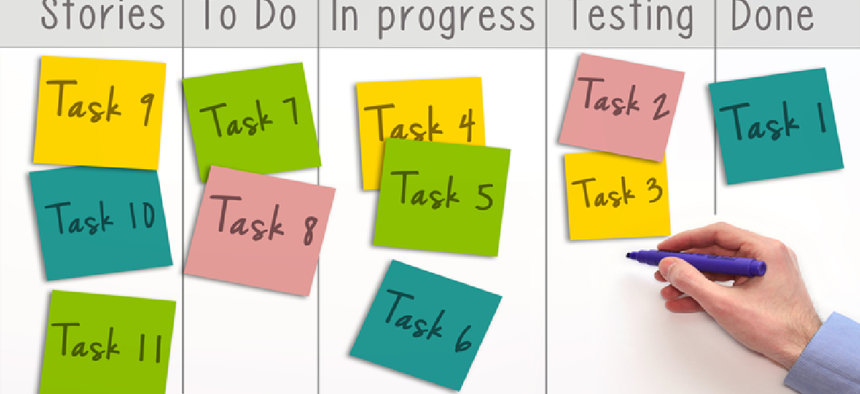3 ways agile can improve communications during contract transitions

Agile communications can provide a lightweight structure for vendor transitions by increasing awareness of progress and challenges and helping managers make more informed decisions.
This article is the first in a series on how government agencies and vendors can apply agile processes and strategies for better contract transitions.
Government agencies can choose from hundreds of approved vendors, and while we all know that choice is good, it can also create challenges. Agencies use multiple vendors for different reasons, and they often find themselves handing off work from one contractor to another. This move can risk interrupting client operations.
Transition timelines, which inject a sense of urgency in the process, are defined by contractual language and often range from 30 to 90 days in the government market. Meeting these deadlines require real-time reporting and communications among the vendor and client teams. Fortunately, with proper planning, smooth and seamless transitions are possible, resulting in stable operations.
Here are three steps that agencies can take to ensure a smooth transition from one contract vendor to the next.
1. Implement a transition communications plan
A key success factor in a smooth handoff is a transition communication plan for the transition team, client and vendor management. A successfully implemented TCP defines the team ceremonies, mechanisms and reporting chains for all transition team members. The TCP is transparent and agile in approach; it is less formal, more people-centric and focused on delivering defined business outcomes.
In the early stages of transition, the vendor team should deploy a lightweight TCP that fosters an environment of direct, continuous and transparent communication between tactical team members executing tasks and the vendor and client management teams. Leveraging agile scrum techniques, the team should institute a daily stand-up meeting -- ideally attended by transition managers and contributors -- to address key technical and administrative activities that need to occur during the transition.
2. Use kanban to track activities
Once a TCP has been developed, the next step is to use kanban boards to visualize progress on a given task or product. A successful artifact for vendor management and reporting on transition activities, kanban boards detail process steps and flows and provide transparency concerning the progress of activities. They are used to identify status at a detailed activity level while providing context to the total transition progress to all stakeholders.
With kanban boards, work-in-progress activities are displayed as columns that identify the outputs to be consumed by the next activity in the sequence. The activities captured on the kanban board should include beginning and ending dates of each task. Tracking this time to complete provides baseline durations and identifies tasks that may be accelerated given additional resource availability.
Good uses cases for kanban boards in government include clearance, onboarding, application review and knowledge transfer and service portfolios.
3. Establish transition-specific escalation procedures
In addition to kanban boards, an issue-escalation process provides a communication mechanism to address blocks (agile blockages) and issues.
Although similar to the project-based transition process, the compressed nature of vendor transitions requires rapid escalation of blocks to stakeholders who can assist the transition team. Examples of transition issues include unavailability of incumbent vendor personnel required for knowledge transition, incomplete process or application documentation or clearance or background investigation delays. These block “issues” detail the categories, severities, impacts, resource assignments and escalation paths to transition specific activities.
Effective transitions require a quick way to respond to and eliminate blocks. Well-defined escalation procedures define the methods for resolving blocks identified during daily standups that are outside the control of the transition team. Within the escalation procedures, resolution plans are created that allow the team to continue working while decision-makers address block issues.
The issue resolution portion of the TCP should cover:
- Issue capture and logging.
- Assignment of responsibility, criticality and target resolution date.
- Issue resolution and closure.
- Issue status reporting.
Lastly, transition management should, at a minimum, review the issues log weekly. These reviews ensure that satisfactory progress is being made toward resolving open issues and provide awareness of the new issues that have been raised during the last period.
Choosing agile over traditional methods leads to smoother transitions
Transitioning work from one vendor to another does not have to be an arduous process. In fact, given the choice between traditional hand-off techniques vs. agile communications processes, it becomes evident that there really is no choice at all.
Application of agile communications techniques and processes can provide a lightweight structure for vendor transition activities. It will increase awareness of progress and challenges and help managers make more informed decisions. It really is the only choice.
NEXT STORY: Army connects dumpsters to IoT





